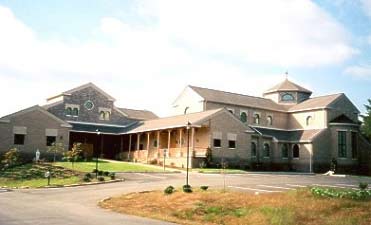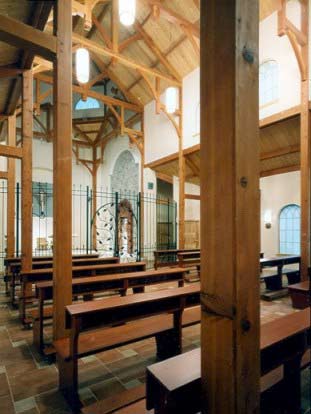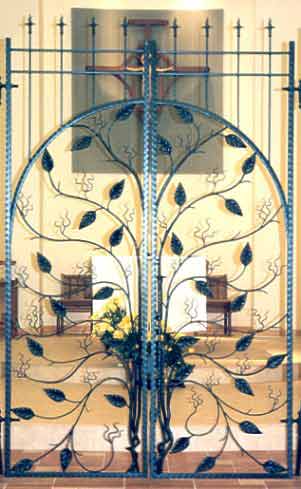|

|
|
|
OUR
PROPERTY
Our Mother St. Clare and her sisters lived their monastic life in
San Damiano, that remote and secluded monastery outside the walls of
the city of Assisi. Here they dwelt apart from the world while
holding the world and all its needs, concerns, hopes and sufferings
close to their hearts. Our Father St. Francis also loved to seek out
places of solitude for prayer and union with God. At Mt. Alverna,
his favorite hermitage, he received marks of the sacred stigmata.
Our cemetery bears this name. It is in the spirit of our holy
Founders that we respond to Christ's invitation to "come away by
yourselves to a lonely place." Mount St. Francis is our place of
solitude, our city set on a hilltop where we are hidden with Christ
in God; where, at the heart of the Church and the world, we serve
the Church and the world. |
 |
|
|
 |
ARCHITECTURE
The architectural team has designed our monastery using a
traditional Romanesque model. The main entrance, with its arched
portico and rose window captures a striking resemblance to Assisi's
San Damiano, home of our Mother St. Clare. Our living space, built
in a quadrangle around an enclosed garden is typical of most
medieval monastic dwellings in the Christian West. The sacred space
comprising the public chapel, the nun's choir, the chapter room and
a small oratory are arranged in a cruciform design using the natural
building materials of wood and stone as much as
possible. Our
guiding principle in the overall
design has been:
Christ in the center of each sister's heart;
Christ at the center of our community life;
the church at the center of the monastery;
the tabernacle at the center of the church.
|
|
|
 |
THE PUBLIC CHAPEL This place of worship, while outside the monastic
enclosure, is also the space of Divine Hospitality. Though we are
not visible, this is where we welcome our friends most intensely
into the fabric of our contemplative life. It is at the liturgy of
the Word and the Eucharist that we share the true banquet for mind
and spirit. Our gaze is not on one another, but on the Lord, present
in the sacrament of His Body and Blood. Here liturgical
celebrations, ceremonies of profession, and private prayer mark the
true rhythm of those who are called to stand at the edge of the
world and await the coming of Christ at every moment. We welcome
visitors to our chapel, either for daily Mass, for the Liturgy of
the Hours, or for time spent in private prayer. May all who come
here find the peace so many have found before the Christ present in
the tabernacle. |
|
THE GRILLE The grille which separates the main body of the church
from the sanctuary and the enclosed area of the nuns choir has gates
designed to recall the episode in the Book of Exodus where God
manifests Himself to Moses in fire burning in a bush without harming
or destroying it. Moses turns aside to look closer at this
remarkable sight and is told to remove the shoes from his feet
because he is standing on holy ground. The early Fathers of the
Church have commented on this text, likening the fire to the Spirit
of God descending into our human nature to set us on fire with his
consuming love that restores our humanity rather than annihilating
it and brings it into communion with Himself. Moses turns aside,
withdrawing the footsteps of his heart from earthly attractions and
stands before the bush. No one stands, says St. Ambrose, but the man
who stands by faith. St. Augustine comments that there is no holier
ground than the Church of God. These gates recall to our minds the
sacred nature of this place where our Lord comes down upon our altar
and remains with us in the tabernacle.
|
 |
|
CONTINUE TOUR OF OUR MONASTERY |
| |
|
| |
|
|
|